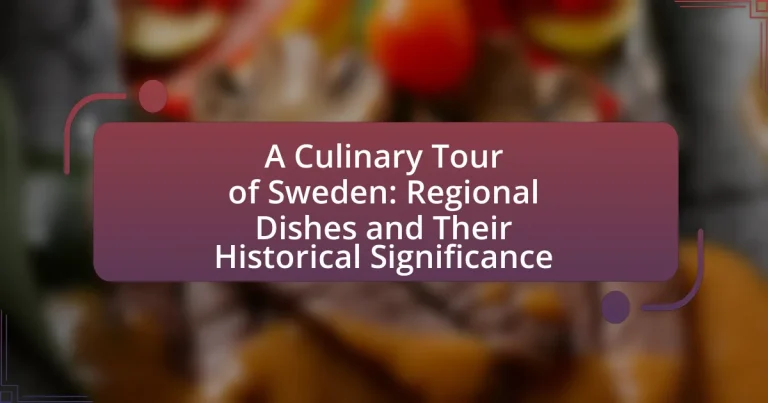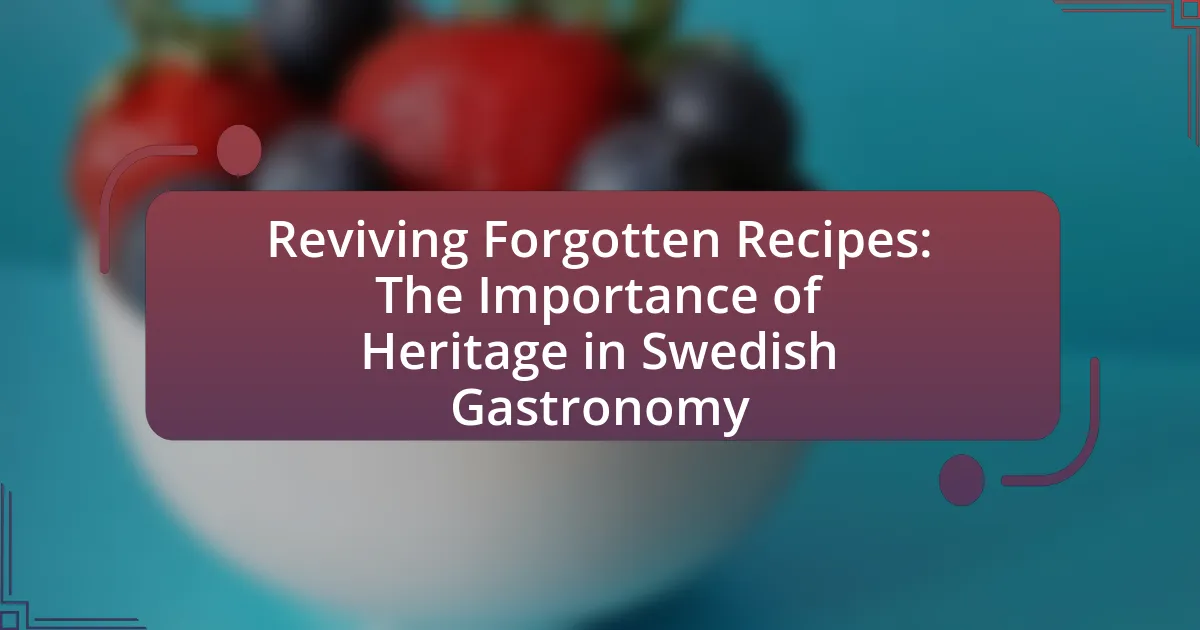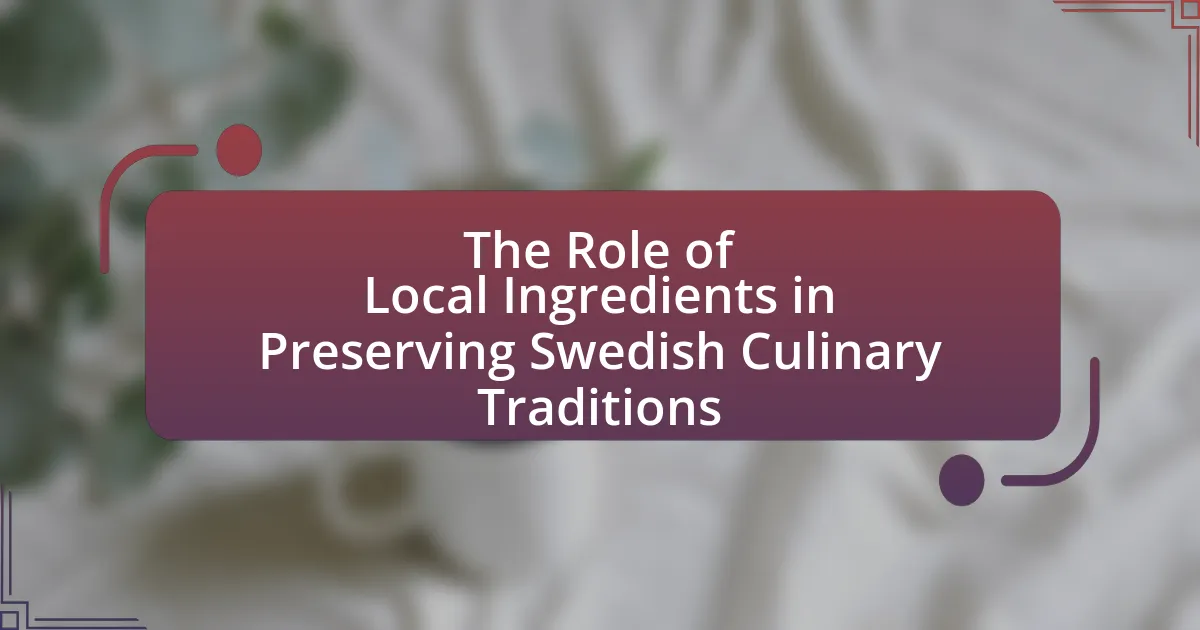The article “A Culinary Tour of Sweden: Regional Dishes and Their Historical Significance” explores the importance of Swedish cuisine as a reflection of the country’s cultural heritage, history, and geography. It examines traditional dishes, such as meatballs and herring, and their connections to local customs and seasonal celebrations. The article highlights how regional ingredients and historical events have shaped culinary practices across different areas of Sweden, emphasizing the role of traditional cooking methods and the impact of contemporary trends. Additionally, it discusses the significance of foraging and local sourcing in promoting sustainability within Swedish cuisine, while providing insights into must-try dishes and tips for experiencing authentic Swedish culinary culture.

What is the significance of Swedish cuisine in the context of cultural heritage?
Swedish cuisine is significant in the context of cultural heritage as it reflects the country’s history, geography, and social customs. Traditional dishes such as meatballs, herring, and crispbread showcase the agricultural practices and fishing traditions that have shaped Swedish society over centuries. For instance, the use of preserved fish and root vegetables in Swedish cooking highlights the necessity of food preservation methods developed during harsh winters. Furthermore, the celebration of seasonal foods, such as crayfish in August and surströmming in late summer, illustrates the connection between culinary practices and local customs. This culinary heritage not only fosters national identity but also promotes regional diversity, as different areas of Sweden have distinct dishes and flavors that contribute to the overall tapestry of Swedish culture.
How do regional dishes reflect the history of Sweden?
Regional dishes in Sweden reflect the country’s history through the incorporation of local ingredients, traditional cooking methods, and cultural influences. For example, the use of fish in dishes like surströmming (fermented herring) highlights Sweden’s extensive coastline and fishing heritage, which dates back centuries. Additionally, the prevalence of root vegetables in northern dishes illustrates agricultural practices shaped by the harsh climate, while the influence of trade routes is evident in the adoption of spices and flavors from other cultures, such as the use of dill and cardamom. These elements collectively showcase how Sweden’s geography, climate, and historical interactions have shaped its culinary landscape.
What are the key historical events that shaped Swedish culinary traditions?
Key historical events that shaped Swedish culinary traditions include the introduction of Christianity in the 11th century, which brought new ingredients and cooking methods, and the establishment of trade routes during the Hanseatic League in the 13th to 17th centuries, facilitating access to spices and foreign foods. The agricultural reforms of the 18th century, including the introduction of new crops like potatoes and turnips, significantly influenced Swedish diets. Additionally, the industrialization in the 19th century led to urbanization and changes in food production and consumption patterns. Each of these events contributed to the evolution of Swedish cuisine, integrating local ingredients with external influences and shaping the culinary landscape of Sweden.
How do local ingredients influence regional dishes in Sweden?
Local ingredients significantly influence regional dishes in Sweden by shaping flavors, textures, and cooking methods unique to each area. For instance, the use of fresh fish from the Baltic Sea, such as herring and salmon, is prevalent in coastal regions, leading to traditional dishes like sill (pickled herring) and gravlax. Additionally, the availability of root vegetables, such as potatoes and carrots, in the agricultural heartlands contributes to hearty dishes like kroppkakor (potato dumplings). The incorporation of local herbs and berries, such as lingonberries and dill, further enhances the distinctiveness of regional cuisines, reflecting the natural resources and culinary traditions of each locality. This reliance on local produce not only preserves cultural heritage but also promotes sustainability within the Swedish food system.
What are the main regions of Sweden known for their unique culinary offerings?
The main regions of Sweden known for their unique culinary offerings are Skåne, Halland, Västra Götaland, and Norrland. Skåne is renowned for its agricultural products and traditional dishes like äggakaka (a type of pancake) and various pickled herring. Halland is famous for its seafood, particularly herring and shellfish, reflecting its coastal geography. Västra Götaland, home to Gothenburg, is known for its seafood and local specialties such as shrimp sandwiches and fish stew. Norrland, the northernmost region, offers unique dishes like reindeer and cloudberries, showcasing its indigenous Sami culture and natural resources. Each region’s culinary offerings are deeply influenced by local ingredients, geography, and historical traditions.
Which dishes are iconic to each region of Sweden?
Sweden’s regions each have iconic dishes that reflect their unique culinary heritage. In Skåne, the traditional dish is “Äggakaka,” a thick pancake often served with lingonberries. In Halland, “Havregrynsgröt,” or oatmeal porridge, is a staple breakfast item. The West Coast is known for “Sill,” pickled herring, which is integral to Swedish cuisine. In Värmland, “Köttbullar,” or meatballs, are a beloved comfort food. Dalarna is famous for “Kroppkakor,” potato dumplings filled with pork. In Norrland, “Surströmming,” fermented herring, is a controversial yet traditional dish. Each of these dishes is deeply rooted in the local culture and history, showcasing the diversity of Swedish culinary traditions.
How do geographical factors affect the cuisine of different regions?
Geographical factors significantly influence the cuisine of different regions by determining the availability of ingredients, climate conditions, and cultural interactions. For instance, coastal regions often feature seafood prominently due to easy access to the ocean, while mountainous areas may rely on livestock and hearty grains suited to colder climates. In Sweden, the abundance of lakes and forests leads to a cuisine rich in fish, game, and foraged ingredients, reflecting the natural resources available. Historical trade routes and migration patterns further shape regional dishes, as seen in the incorporation of spices and cooking techniques from various cultures. Thus, the interplay of geography and local resources directly shapes the culinary identity of a region.
What role do traditional cooking methods play in Swedish cuisine?
Traditional cooking methods are fundamental to Swedish cuisine, as they preserve cultural heritage and enhance flavors. Techniques such as smoking, pickling, and fermenting have been used for centuries, allowing for food preservation and the development of unique tastes. For instance, the traditional method of gravlax involves curing salmon with salt, sugar, and dill, a practice dating back to the Middle Ages, which showcases the importance of these methods in maintaining food quality and tradition. Additionally, the use of open-fire cooking and baking in wood-fired ovens reflects regional practices that contribute to the distinctiveness of Swedish dishes, reinforcing the connection between food and cultural identity.
What are some common traditional cooking techniques used in Sweden?
Common traditional cooking techniques used in Sweden include boiling, baking, smoking, and pickling. Boiling is often employed for preparing dishes like köttbullar (meatballs) and various root vegetables. Baking is significant in making traditional breads such as knäckebröd (crispbread) and pastries. Smoking is a prevalent method for preserving fish, particularly salmon, which is a staple in Swedish cuisine. Pickling is widely used for vegetables and herring, reflecting the historical need for food preservation in Sweden’s cold climate. These techniques are integral to Swedish culinary heritage and contribute to the unique flavors and preservation methods of regional dishes.
How have these methods evolved over time?
Culinary methods in Sweden have evolved significantly from traditional practices to modern techniques. Historically, preservation methods such as smoking, pickling, and fermenting were essential for food sustainability, particularly in the harsh Nordic climate. Over time, these methods have integrated contemporary cooking techniques, including sous-vide and molecular gastronomy, which enhance flavors and textures while maintaining the essence of regional dishes. The shift towards local and organic ingredients has also influenced cooking methods, promoting a farm-to-table approach that emphasizes freshness and sustainability. This evolution reflects broader culinary trends while honoring Sweden’s rich gastronomic heritage.

How do specific regional dishes embody Swedish culture?
Specific regional dishes in Sweden, such as surströmming from the northern regions and köttbullar from central Sweden, embody Swedish culture by reflecting local ingredients, historical practices, and communal traditions. Surströmming, fermented herring, showcases the coastal communities’ reliance on fishing and preservation methods developed over centuries, while köttbullar, or meatballs, highlight the agricultural heritage and the importance of family meals in Swedish society. These dishes not only represent the geographical diversity of Sweden but also serve as cultural symbols during celebrations and gatherings, reinforcing social bonds and national identity.
What are the most famous dishes from each region of Sweden?
The most famous dishes from each region of Sweden include:
- Norrland: Surströmming (fermented herring) is a traditional dish known for its strong odor and unique flavor, often consumed with flatbreads.
- Svealand: Köttbullar (meatballs) are iconic, typically served with lingonberry sauce and creamy gravy, reflecting Swedish home cooking.
- Götaland: Smörgåsbord, a buffet-style meal featuring various dishes like herring, cured meats, and cheeses, showcases the region’s culinary diversity.
- Öland: Ölandskörsbär (Öland cherries) are celebrated in desserts and jams, highlighting the island’s agricultural heritage.
- Gotland: Saffranspannkaka (saffron pancake) is a sweet dish that represents the island’s unique culinary traditions.
These dishes are significant as they reflect the local ingredients and cultural practices of each region, contributing to Sweden’s rich culinary heritage.
What ingredients are essential in these regional dishes?
Essential ingredients in regional Swedish dishes include potatoes, herring, lingonberries, and dill. Potatoes serve as a staple in many meals, often prepared in various forms such as boiled or mashed. Herring, particularly pickled, is a traditional fish used in dishes like sill, reflecting Sweden’s coastal heritage. Lingonberries provide a tart contrast to savory dishes and are commonly served with meatballs. Dill is a key herb that enhances the flavor of many Swedish recipes, including gravlax. These ingredients are integral to the culinary identity of Sweden, showcasing the country’s agricultural resources and historical influences.
How do these dishes connect to local customs and celebrations?
Swedish dishes connect to local customs and celebrations through their incorporation into traditional festivities and seasonal events. For example, dishes like herring and meatballs are integral to Midsummer celebrations, where families gather to enjoy a meal that symbolizes the arrival of summer. Additionally, during Christmas, dishes such as julskinka (Christmas ham) and lutfisk (dried fish) are served, reflecting centuries-old traditions that emphasize communal dining and seasonal ingredients. These culinary practices not only preserve cultural heritage but also reinforce social bonds within communities during significant occasions.
Why is foraging and local sourcing important in Swedish cooking?
Foraging and local sourcing are important in Swedish cooking because they emphasize the use of fresh, seasonal ingredients that reflect the country’s natural landscape. This practice not only enhances the flavor and nutritional value of dishes but also fosters a connection to local traditions and sustainability. Sweden’s diverse ecosystems provide a rich variety of edible plants, mushrooms, and berries, which have been integral to its culinary heritage for centuries. Historical evidence shows that traditional Swedish cuisine has always relied on what the land offers, promoting a sustainable approach to food that respects the environment and local biodiversity.
What are the benefits of using locally sourced ingredients in Swedish cuisine?
Using locally sourced ingredients in Swedish cuisine enhances freshness, supports local economies, and promotes sustainability. Freshness is critical as locally sourced ingredients are often harvested at peak ripeness, resulting in superior flavor and nutritional value. Supporting local farmers and producers strengthens the community and reduces transportation emissions, contributing to environmental sustainability. Additionally, the use of seasonal ingredients fosters a connection to Swedish culinary traditions, reflecting the country’s agricultural heritage and seasonal cycles. This practice not only preserves local biodiversity but also encourages the consumption of traditional dishes that are integral to Sweden’s cultural identity.
How does foraging contribute to the sustainability of Swedish culinary practices?
Foraging significantly contributes to the sustainability of Swedish culinary practices by promoting the use of local, seasonal ingredients that reduce reliance on industrial agriculture. This practice encourages biodiversity, as foragers collect a variety of wild plants, mushrooms, and berries, which helps maintain healthy ecosystems. Furthermore, foraging supports traditional knowledge and cultural heritage, as it is deeply rooted in Swedish history and fosters a connection between people and their environment. Studies indicate that foraging can enhance food security by diversifying diets and providing access to nutritious foods that are often overlooked in commercial markets.

What are the contemporary trends in Swedish cuisine?
Contemporary trends in Swedish cuisine emphasize sustainability, local sourcing, and a focus on seasonal ingredients. This shift is driven by a growing awareness of environmental issues and a desire for healthier eating habits. For instance, many Swedish chefs are incorporating foraged ingredients, such as wild herbs and mushrooms, into their dishes, reflecting a connection to nature and traditional practices. Additionally, the popularity of plant-based diets has surged, with restaurants offering innovative vegetarian and vegan options that highlight Swedish flavors. The New Nordic Cuisine movement, which champions simplicity and purity in food preparation, further influences these trends, promoting dishes that celebrate the natural taste of high-quality, locally sourced ingredients.
How are modern chefs reinterpreting traditional Swedish dishes?
Modern chefs are reinterpreting traditional Swedish dishes by incorporating innovative techniques and global flavors while maintaining the essence of the original recipes. For instance, chefs are using sous-vide cooking methods to enhance the texture of classic dishes like meatballs, ensuring they remain juicy and tender. Additionally, ingredients such as quinoa and avocado are being introduced into traditional recipes like Jansson’s Temptation, creating a fusion that appeals to contemporary palates. This approach not only preserves the cultural significance of the dishes but also adapts them to modern dietary preferences, reflecting a broader trend in culinary practices where tradition meets innovation.
What innovative techniques are being used in Swedish kitchens today?
Innovative techniques in Swedish kitchens today include the use of fermentation, sous-vide cooking, and foraging for local ingredients. Fermentation is increasingly popular for enhancing flavors and preserving foods, as seen in traditional dishes like surströmming (fermented herring). Sous-vide cooking allows for precise temperature control, resulting in perfectly cooked meats and vegetables, which is gaining traction among chefs for its consistency and quality. Additionally, foraging emphasizes the use of wild, seasonal ingredients, reflecting a commitment to sustainability and local sourcing in Swedish cuisine. These techniques not only elevate the culinary experience but also align with contemporary trends in health and environmental consciousness.
How do contemporary trends reflect global influences on Swedish cuisine?
Contemporary trends in Swedish cuisine reflect global influences through the incorporation of diverse ingredients and cooking techniques from various cultures. For instance, the rise of fusion dishes, such as sushi-inspired herring or tacos with Swedish meatballs, showcases how traditional Swedish flavors are being blended with international culinary practices. Additionally, the increasing popularity of plant-based diets has led to the adaptation of classic Swedish recipes, like replacing meat in kottbullar (meatballs) with lentils or chickpeas, aligning with global health trends. This evolution is supported by the growing presence of international restaurants and food markets in Sweden, which introduce new flavors and cooking styles, further enriching the local culinary landscape.
What are some tips for experiencing Swedish cuisine authentically?
To experience Swedish cuisine authentically, prioritize dining at traditional restaurants that serve classic dishes like meatballs, herring, and gravlax. Engaging with local food markets, such as Östermalm Market in Stockholm, allows for sampling regional specialties and fresh ingredients. Additionally, participating in a Swedish cooking class can provide hands-on experience with authentic recipes and techniques. Exploring regional variations, such as the seafood of the west coast or the game dishes from the north, enhances understanding of Sweden’s culinary diversity. These practices are supported by Sweden’s rich culinary heritage, which emphasizes seasonal ingredients and traditional cooking methods.
How can travelers find the best local dishes during their visit to Sweden?
Travelers can find the best local dishes during their visit to Sweden by exploring traditional markets, dining at local restaurants, and participating in food tours. Traditional markets, such as Östermalms Saluhall in Stockholm, offer a variety of authentic Swedish foods, including cured meats and artisanal cheeses. Local restaurants often feature seasonal menus that highlight regional specialties like herring and meatballs. Food tours provide guided experiences that introduce travelers to local culinary traditions and hidden gems, ensuring they sample dishes that reflect Sweden’s rich gastronomic heritage.
What are some must-try dishes for anyone exploring Swedish culinary culture?
Some must-try dishes for anyone exploring Swedish culinary culture include meatballs, herring, and gravlax. Swedish meatballs, known as köttbullar, are typically served with lingonberry sauce and creamy gravy, reflecting the country’s tradition of hearty, comforting food. Herring, often pickled or marinated, is a staple in Swedish cuisine, showcasing the importance of fish in the Nordic diet. Gravlax, a cured salmon dish, highlights Sweden’s seafood heritage and is often accompanied by a mustard sauce. These dishes not only represent the flavors of Sweden but also embody the historical significance of local ingredients and culinary practices.





